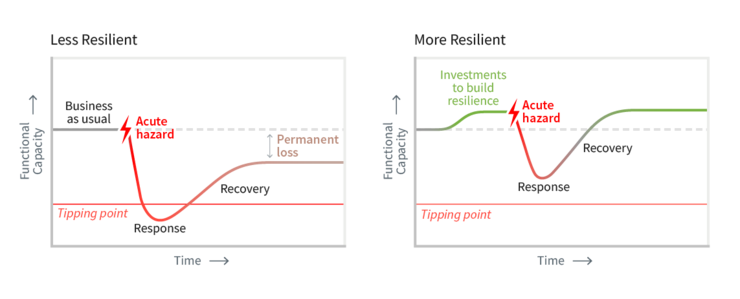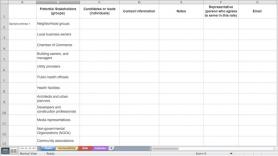These graphs illustrate two levels of resilience. On the left, a community operates at a steady state until an acute hazard occurs. In response, the level of service drops below a tipping point; the community recovers somewhat, but suffers a permanent loss. On the right, actions taken prior to an acute hazard increase the community capacity. From this higher baseline, the same acute hazard still requires a period of recovery, but no irreversible damage occurs. Building resilience means improving conditions that help a community accommodate future disruptions.
Get Started
Addressing climate issues takes a trusted leader who knows how to get things done in their community—a climate champion.
An effective champion, whether inside government or a member of the community at large, works with a planning team to assess climate risk and make recommendations on how to address it.
New to this site?
This Toolkit aims to help climate champions and their communities protect the things they care about from climate-related hazards. The Toolkit can guide you through the development of an equitable climate resilience plan.
Not sure what we mean by resilience?
Resilience is the capacity of a community, business, or natural environment to prevent, withstand, respond to, and recover from a disruption. Climate resilience refers to situations where the disruptions are related to climate. These include events such as extreme weather, drought, and flooding.
Financial losses from climate-related hazards cost our nation billions of dollars every year. Taking action to build resilience can improve our current quality of life and reduce costs related to future hazards.
Efforts to build climate resilience are increasingly seen as opportunities to prepare for changing climate conditions, reduce emissions of greenhouse gases, and work with others to address social equity.
Here's a graphic description of resilience
Where are the tools?
Tools available through the Toolkit are digital resources that can help with some stage of building climate resilience. The tools we point to can help you
- find climate data to document past, present, and projected conditions at your location,
- access demographic and social data to help identify areas of need, and
- learn about strategies for engaging community members to co-develop a resilience plan.
Each tool listed in our catalog has a short description and a link to the tool. Filters help you zero in on the tools that can meet your needs.
Ready to build resilience? Identify a climate champion
A trusted leader who makes it a top priority to protect their community from climate hazards can serve as a climate champion. Often, this leader is an elected official, a sustainability coordinator, or someone who works in a local government office. Individuals who work outside of government can also serve in this role: as community-based organizations and businesses are keenly interested in protecting local assets, individuals from these groups are well-suited to rally residents around a goal to build climate resilience.
If you are ready to serve as a climate champion, or support the efforts of another person in this role, these pages can guide you through a finite process to explore your climate risk and build your climate resilience.
Build a representative team
- To ensure your efforts are inclusive, communicate your climate-related concerns to people across your networks. Speak about climate early and often, and listen carefully to feedback and additional input.
- Prepare talking points or a make public presentations about potential issues and possible solutions.
- At a minimum, your core team should include government agency representatives and leaders of frontline communities—those who are experiencing the first and worst impacts from climate change. Encourage potential planning team members to recognize they can make important contributions to adapt to our changing climate.
You can access a prepared worksheet to help you compile your Planning Team Contact List »
Other considerations for building your planning team
Consider your community’s history
- Identify and acknowledge the systemic patterns and biases that shape your community. Explore the historical legacies of racism and socioeconomic inequality to recognize their current consequences.
- Pay special attention to areas where income is low, pollution is high, or access to services is limited.
- To build resilience for all, acknowledge and address these issues and their potential solutions in every step of your project.
Check for missing viewpoints
- Do all groups who might be affected by issues you chose to explore have trusted representatives on your planning team?
- Reach out to identify and engage with unrepresented subgroups of your community. Share your ideas and listen to theirs. Invite leaders of these groups to join your planning team.
Groups to consider involving
- Local government staff: consider recruiting representatives from government agencies (Public Works, Emergency Management, Sustainability, Housing, Health and Human Services, Finance, Transportation, Parks and Recreation, etc.), including those responsible for social and economic priorities.
- Community partners: draw upon existing community partnerships and foster new relationships with trusted frontline community leaders, faith-based groups, and community-based organizations that are working to advance racial, economic, and environmental equity, sustainability, and community development. Community partners should be compensated for lending their expertise and should have an equal voice and influence to shape all aspects of the process as part of the Planning Team.
- Regional Governance: invite regional, state, and federal agency representatives with jurisdiction over regional transportation, energy, and water infrastructure systems, as well as social services such as public housing, welfare, risk insurance, and building codes.
- Private sector and philanthropic organizations: engage existing partners in the private sector and seek new relationships with leaders of community groups. Consider institutions that have a large stake in community resilience such as hospitals and companies that employ large numbers of local residents).
- Academic institutions: consider which universities, colleges, and community education centers have experts with skills and experience that may prove useful for your project.
- Scientists and other experts: look for individuals or groups that enhance the group's sense of place and value for the natural assets and ecosystems in your area.
- Residents of the community: recruit a diverse range of individuals who can bring valuable perspectives and contribute expertise to planning efforts.
Consult existing planning documents
To be eligible for federal programs such as disaster relief, cities and counties are required to develop and file official planning documents such as a Comprehensive Plan and Hazard Mitigation Plan. Search for your community's documents online or among city records.
Review the documents and follow-on meeting notes to identify people, groups, or other information that could be relevant to your climate concerns.
- What problems, opportunities, and plans has the community already identified?
- Which of these might connect to your climate concerns?
- What groups or individuals have expressed interest in issues related to yours? If they are still active, consider joining their effort, or asking them to share what they've learned.
Commit to centering equity in your plan
Equity in climate resilience implies that neither race, class, ability, nor other social characteristics should determine individual or group preparedness for the impacts of climate variability and change. Equitable planning processes serve as public demonstrations that opportunities are available to everyone, no matter their background. Centering equity in every decision of the planning process can help groups come up with inclusive solutions that work for everyone.
See the Toolkit's Equity page to learn more.
Check alignment of your developing goals with community values
- Ask yourself: If the project you are beginning to envision is successful, will the outcomes be equitable for all? Or will achieving your goal simply pass social or economic costs from one group to another?
- Will your efforts address the needs of those most in need?
- Check that a popular idea for addressing a relatively small issue in one part of the community will not leave a genuine hardship unaddressed in another area.
Announce your effort to the public
Use relevant channels to share your ideas with the community. You might
- plan, advertise, and hold a public meeting
- develop a summary and post it on local social media
- build a publicly accessible webpage
- publish a notice in a community newsletter or local newspaper
Plan ahead so you are prepared to respond to questions from community members who are just learning of the project.
The next step, Understand Exposure, will help you zero in on the things that you most want to protect and the hazards that you may need to protect them from.
You may find it useful to download and complete this prepared spreadsheet to record input as you move through the steps.
Access the Glossary for definitions and examples of words related to resilience.





